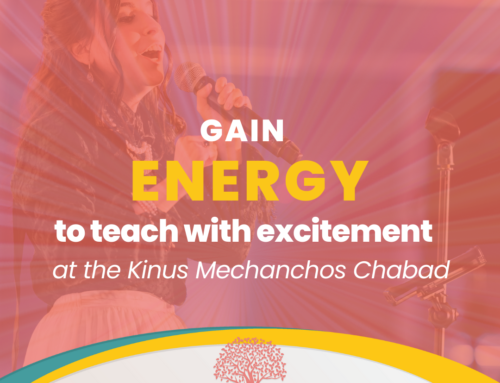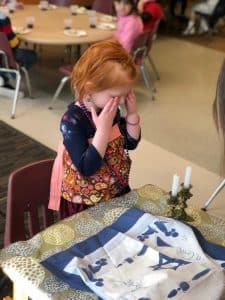 by Chanah Rose
by Chanah Rose
Sitting with a group of friends at a Shabbos afternoon shiur, we digressed to talk about what our goals are for our children.
“To be frum.” “To be healthy and happy.” “To fulfill their potential.” We were grappling for words.
What if the same question was posed to a group of teachers? We might hear things like, “to gain skills for lifelong learning.” “To build self-confidence.” “To be inspired about their Yiddishkeit and Chassidishkeit.”
These are all valuable and uplifting goals. However, in education we know that having an overarching goal helps focus all of our planning and efforts in the classroom – “backwards design,” or in lashon chazal, סוף מעשה במחשבה תחלה.
Fortunately, the Yom Tov of Shavuos, when we receive the very Torah upon which our Chinuch efforts are founded, reminds us of a deeply meaningful goal that we can choose to make our own. The Frierdiker Rebbe introduced a unique bracha for Shavuos – קבלת התורה בשמחה ובפנימיות, to receive the Torah with joy and inwardness. With these words, we are gifted with direction and clarity as to how to convey our precious Mesorah to our students and children.
***
To teach with Simcha is a tradition that was handed down all the way from Rava, the Amora who opened each lesson with a joke – a מילתא דבדיחותא. Humor opens the heart and mind, so that subsequent learning has a clear pathway to enter.
In “The Educator’s Handbook,” Rabbi Hodakov emphasizes the importance of Simcha, creating a festive atmosphere in school on special occasions and infusing joy whenever possible. Educational studies reflect this truth that the emotional climate in the classroom is a primary factor in student success.
While infusing a sense of fun and lightheartedness in the classroom community is a valuable goal, a further challenge is bringing Simcha into the learning itself. The most effective way of doing this is by demonstrating how much the teacher him or herself enjoys teaching and learning this subject matter, sharing an authentic sense of “geshmak” with their students.
Multiple modalities and learning styles help students enjoy the process of learning, and we can even maintain an upbeat attitude when learning or behavior goes wrong. As Mrs. Nami Friedman, assistant principal at Yeshiva Schools of Pittsburgh, shared on a recent Mechanchos Farbrengen, she has started using the phrase “my favorite mistake” when students get a wrong answer that reflects effort and a valuable thought process that didn’t quite land on the right answer. Similarly, Mrs. Perel Hodakov, a 5th grade teacher in Lubavitch Hebrew Academy, FL, shared code words and phrases she uses to gently redirect her students, referencing funny mashalim and videos that they have previously discussed. (“Don’t get stuck on the elevator,” and “Who’s in the driver’s seat?” are some examples you can hear more about here.)
These are all techniques that make the process of learning a joyful experience. But how do we also ensure that the content we are learning is a source of joy for our students, such that Torah becomes their greatest pleasure and their path to happiness throughout their lives?
I think the answer lies in the connection between the two halves of the Frierdiker Rebbe’s bracha. Simcha creates a pathway to help students internalize their learning, with any obstructions laughed out of the way, and their positive attitude abetting their success. Similarly, helping our students internalize their learning, and teaching in a way that emphasizes Pnimiyus, will help them feel at one with Torah and at peace with their Yiddishkeit. Joy leads to Pnimiyus, and Pnimiyus leads to joy.
***
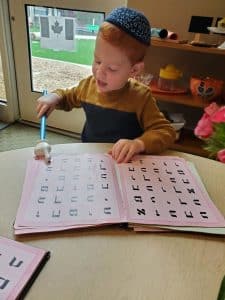 In a recent Hayom Yom (22 Iyar), we learned that “The Rebbe (the Alter Rebbe) had accomplished something novel – that we are not alone. At one time, the Master – Rosh Yeshiva or Talmudic sage – was “alone” and his disciples were “alone.” The chassidic way instituted by the Rebbe is a tremendous Divine achievement, that the Rebbe is not alone, nor are the chassidim alone.”
In a recent Hayom Yom (22 Iyar), we learned that “The Rebbe (the Alter Rebbe) had accomplished something novel – that we are not alone. At one time, the Master – Rosh Yeshiva or Talmudic sage – was “alone” and his disciples were “alone.” The chassidic way instituted by the Rebbe is a tremendous Divine achievement, that the Rebbe is not alone, nor are the chassidim alone.”
In addition to the strength of the Rebbe-Chassid bond, there are other facets of meaning that we can learn from this Hayom Yom. One is that Chassidus introduced a tremendous emphasis on Pnimiyus – on pnimiyus ha’Torah, the pnimiyus hakavana of creation, and the Pnimiyus of every Yid, and this is the reason that neither Rebbe or Chassid need feel alone anymore.
A person can be in a crowded room, filled with family and friends, but if there is a precious secret he holds deep inside of him and doesn’t feel comfortable to reveal, he can still feel lonely.
By contrast, if he finds himself with just one person with whom he finds he shares a common language, and can unburden himself of his soul’s deepest yearnings, he is no longer alone.
By introducing Chassidus, the Rebbe was able to share with Chassidim the task of uncovering G-dliness in this world, and the vision for what reality is really all about. In turn, Chassidim can feel part of the Rebbe’s vision, and can feel seen for their deepest yearnings to feel connected to Hashem, with their deepest struggles and quandaries heard and addressed. In this way, in our innermost beings, the Rebbe and Chassidim are connected.
When we teach our students, does the Torah remain in one place – elevated and aloof, an idea – and the students in another, filling in the right answers for all their test questions but with their own concerns remaining unvoiced and unanswered? Or can we give them the Torah the way our Rebbeim did for us, in a way that fosters connection, that engages with their inner lives and concerns, and has relevance for them and their life’s mission?
By creating a pnimiyusdike connection between us and our students, and between the Torah and our students – just as with Simcha, we open doors and bring down barriers. And the Frierdiker Rebbe’s bracha can be fulfilled.
***
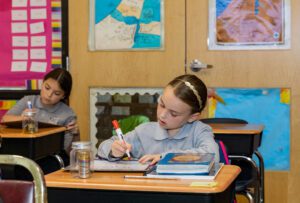 What are some practical ways to emphasize Pnimiyus in the classroom? The first step is to create a connection with our students, so that they are fully present in the classroom, bringing their whole selves along. Then, we can begin to make a connection with the material.
What are some practical ways to emphasize Pnimiyus in the classroom? The first step is to create a connection with our students, so that they are fully present in the classroom, bringing their whole selves along. Then, we can begin to make a connection with the material.
Allowing for and encouraging questions helps students unearth their personal points of engagement with the subject matter.
For example, before teaching a unit on Tefilla, I ask students to pass up anonymous slips of paper with any questions they may have about Tefilla, and try to research and include the answers in the coming lessons on the topic. The same can be done before teaching a story in Tanach, or any other topic, and questions can even be listed on the board and checked off as they are addressed (an idea shared in a teacher training seminar by Mrs. Horowitz a”h, in Seminary Chaya Mushka, Tzfas). When the unit has been completed, time can then be designated for an informal “farbrengen,” where students can discuss their questions, thoughts, and u’v’cheins regarding what they learned.
Creativity is another great conduit for bringing learning b’pnimiyus. In the Hayom Yom of 14 Menachem Av, we find writing referred to as “the quill of the heart,” allowing us to internalize our learning. Assigning projects that involve creative writing or other modalities helps students integrate their academic learning with their creative, inner selves. Teaching through songs, stories, and some of the excellent Chassidic art and poetry1See for example SarasJewishArt.com, Chana Laber @laberoflove, poetry by Simcha Wasserman in books published by Kehos as well as excerpted on Chabad.org, poetry by Tzvi Yair (Rabbi Tzvi Meir Steinmetz) found in his Hebrew books and excerpted/translated on tzviyair.com, and many more. The Frierdiker Rebbe’s writings in the Lubavitcher Rebbe’s Memoirs, Likkutei Diburim and more are often very poetic and are also a great teaching tool to connect students to the lachluchis of Chassidus. that is now widely available, helps students access the learning experientially and connect to it in new ways. (See a previous Shavuos article, Matan Torah: Making it Real, for more examples of learning through creativity.)
At the core of internalizing learning is personal relevance. As the Rebbe found the yayna shel Torah, the delicious “wine” – referring to the personal application – in every Rashi sicha, it is up to us to draw lines of personal relevance between our teaching and our students. Sometimes the lines are clear and straight. At other times, they are more open-ended, and it’s okay to put the question to our students: “What would you do in a similar situation?” “When did you feel this way, and why?” “How can we be a little bit more like this person we are learning about?”
There is even relevance to topics that seem to be more connected to haskala than to avoda. When a girl wrote a letter to the Rebbe asking why we need to learn lofty concepts in Chassidus, the Rebbe responded that learning about Hashem and the vast complexity of the upper worlds, helps us achieve a sense of awe and an awareness of Hashem’s detailed involvement in creation. The personal relevance here is a sense of Hashgacha Pratis and Yiras Shamayim – a less tangible u’vchein than a practical hachlata, but an u’vchein nonetheless.
In order to make that connection, we need to help our students dwell on these concepts, even asking them to close their eyes and imagine how much this all-powerful Hashem, Creator of infinite worlds and madreigos, cares for the minute details of my own life. This is hisbonenus, and it is not beyond us. The u’v’chein may not be actionable in a tangible sense, but in terms of mindset and connection to Hashem, it very much is.
Finally, we need to help our students make Torah personal. Before receiving the Torah, the Jews said “naaseh v’nishma,” we will do and we will hear. Kabolas Ol is the foundation to accessing Torah and Mitzvos, but the next step is to hear – to internalize, understand, and personalize.
Students have various hobbies, interests and talents, and connecting them to Torah is a sure way for the students – nefesh habehamis included – to feel “plugged in.” For one child this can be an emphasis on niggunim, and for another it could be building a Lag B’Omer float. Our mitzvos, minhagim and chassidishe hanhagos provide a rich tapestry of multiple modalities for connection, if only we look for them.
Every Jew has a mitzvah that they are “zahir t’fey,” extra-scrupulous in – or, according to another meaning of the word zahir, a mitzvah in which they shine. My favorite question to ask students is, what is your favorite mitzvah / chassidishe hanhaga / dvar Torah / story / niggun (depending on the group and context.) As teachers, we have the special opportunity to expose our students to these multiple modalities, and to help them cultivate a “favorite” – a personal way to connect.
***
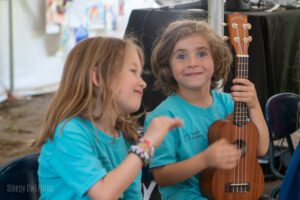 Once we are connected, b’pnimyus, the Simcha also flows. Ein simcha k’hatoras hasfeikos – there is no joy like the resolution of doubt, and even more so of inner conflict. In a beautiful sicha on Shavuos of 5751, the Rebbe explains how Torah brings about tranquility by erasing dichotomies and smoothing the jagged edges of existential angst. When a child has all parts of him or herself connected to Torah and Mitzvos, and they do not need to have a double identity – one that they bring with them to the classroom, and one that they leave outside the door – then the simcha can flow. They are whole. They are complete. They are at ease.
Once we are connected, b’pnimyus, the Simcha also flows. Ein simcha k’hatoras hasfeikos – there is no joy like the resolution of doubt, and even more so of inner conflict. In a beautiful sicha on Shavuos of 5751, the Rebbe explains how Torah brings about tranquility by erasing dichotomies and smoothing the jagged edges of existential angst. When a child has all parts of him or herself connected to Torah and Mitzvos, and they do not need to have a double identity – one that they bring with them to the classroom, and one that they leave outside the door – then the simcha can flow. They are whole. They are complete. They are at ease.
When we infuse Torah study with Simcha, and connect our students to Torah b’pnimyus, then we are helping the Frierdiker Rebbe’s bracha for Shavuos come true. As educators, we are proficient in planning our lessons, our units, and our year. Now that we have our goal articulated for us, we can work backwards, planning lessons, activities, experiences and conversations that can achieve this objective. And when we review our preparation for teaching, we can ask ourselves: Will this lead to Simcha? Will this lead to Pnimiyus? If yes, we are achieving our goal.
In the words of the Frierdiker Rebbe2 Likkutei Dibburim Volume 4, Chapter 30A, Section 10 (Kehos, translated by Uri Kaploun.), “May Hashem grant that we all prepare well to receive the Torah inwardly, so that whatever Mitzvos the Torah commands us to do, we will fulfill with lively vitality.” May this be true for us, our children, and our students, this year and always.
Mrs. Chanah Rose is the Educational Director of Menachem Education Foundation. She can be reached at c.rose@mymef.org.
- 1See for example SarasJewishArt.com, Chana Laber @laberoflove, poetry by Simcha Wasserman in books published by Kehos as well as excerpted on Chabad.org, poetry by Tzvi Yair (Rabbi Tzvi Meir Steinmetz) found in his Hebrew books and excerpted/translated on tzviyair.com, and many more. The Frierdiker Rebbe’s writings in the Lubavitcher Rebbe’s Memoirs, Likkutei Diburim and more are often very poetic and are also a great teaching tool to connect students to the lachluchis of Chassidus.
- 2Likkutei Dibburim Volume 4, Chapter 30A, Section 10 (Kehos, translated by Uri Kaploun.)


